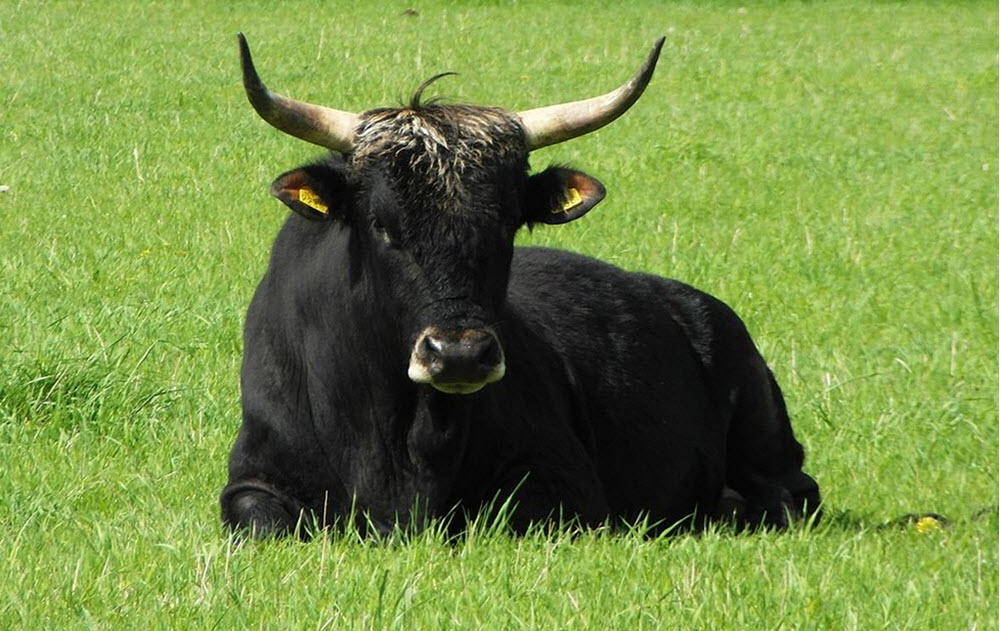Tauros programme
Contents
Tauros programme (formerly known as the TaurOs Project) aims to breed a type of cattle that resembles the extinct aurochs (Bos primigenius). The aurochs was a wild species of large cattle that once inhabited parts of Europe, Asia and northern Africa. While the wild form is extinct, the aurochs is the ancestor of our modern-day domestic European cattle.
By the 13th century AD, the aurochs’ formerly vast geographical range had shrunk to a few places in Europe, including Poland, East Prussia, Lithuania, Moldavia, Bulgaria, and Transylvania. The last recorded aurochs was a female who died in 1627, in the Jaktorów Forest in Poland.

Overview
Launched back in 2008, the Tauros Programme is an international cooperation between the Stichting Taurus foundation in the Netherlands and several universities, including the Wageningen University and Research Centre.
By early 2016, the project had reached its fourth cross-generation.
The aim is to eventually release Tauros cattle into rewilding areas, and the longer-term goal is to have Tauros cattle move freely in Europe just like deer, elk, wild boar, etc.
The aurochs used to be one of the dominating ungulates in Europe, before gradually being reduced in numbers over the course of many centuries. Herbivorous megafauna is considered essential for the preservation of certain types of open habitats, as their grazing makes it more difficult for a forest to develop. If open land is simply left alone without human intervention, it will become a new forest fairly quickly in many parts of Europe, unless animals keep it open through grazing or by disturbing the soil and roots.
Where are the Tauros herds now?
Over time, the project has gradually expanded to include more and more locations in Europe, but the Netherlands is still the hub and has the largest number of herds.
– Nature reserve Keent (Oss), in the Netherlands
– Kempen-Broek (Weert), in the Netherlands
– Herperduin-Maashorst (Oss/Uden), in the Netherlands
– Kraaijenbergse Plassen (Cuijk), in the Netherlands
– De Maurik (Mill), in the Netherlands
– Geuzenbos (Rotterdam), in the Netherlands
– Faia Brava, in Portugal (added in 2013)
– Campanarios de Azaba, in Spain (added in 2013)
– The Lika plains at the foot of the Velebit Mountains, in Croatia (since 2014)
– Sfântu Gheorghe (Danube Delta), in Romania (since 2015)
– Milovice Nature Reserve, in the Czech Republic (since 2015)
– Modrá (Uherské Hradiště district), in the Czech Republic (since 2018)
Which breeds are used?
Presently, nine different cattle breeds are used in the project.
- Boškarin
- Highland Cattle
- Limia Cattle
- Maronesa
- Maremmana primitiva
- Pajuna Cattle
- Podolica
- Sayaguesa Cattle
- Tudanca Cattle
In the Netherlands, all the breeds except Boskarin have been included. Outside the Netherlands, Boskarin, Maronesa, Maremmana, and Sayaguesa are the dominating founding breeds, but cross-breeds imported from the Netherlands are also included.
All the selected breeds are hardy and suitable for living outdoors year round in many parts of Europe. Several of the breeds – including Maremmana primitivo, Pajuna, (Italian) Podolica, and Sayaguesa hail from either the Iberian or the Italian peninsula.
Heck cattle
The Tauros project is not the first attempt to breed aurochs-like cattle in Europe. The most famous project was launched in the 1920s by Lutz and Heinz Heck, who used several different cattle breeds to produce a hardy breed they named after themselves. Today, Heck cattle is used in many open landscape conservation projects, especially in Germany. You can see a picture of Heck cattle here.
While Heck cattle are sturdy, they do differ from aurochs in several notable ways. The Taurus project aims to create a breed that is much more similar to the aurochs.